A Stroll Through Rebel Cork
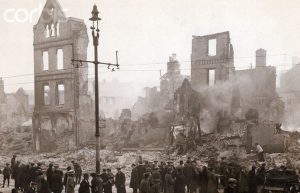
By Dara Burke. Dara runs a Cork city walking tour in his spare time
Picture the scene. Groups of armed men stalking Cork city, firing into the air, smashing shop windows, setting fire to buildings. Turning their rifles on a terrified local population, who are trying to get home before military curfew.
The looting starts as the Tans and Auxiliaries gather around Patrick Street. The main thoroughfare of the city; in the background, you can hear rifle shots, bombs exploding and buildings being set alight. The air is filled with a cloud of thick black smoke. An odour of burning wood spreads around the city. Smashed glass lays strewn over the ground.
As the fire brigade are summoned. The firemen quickly become targets. They are shot at – with two wounded. Their hoses are cut. Pretty soon the terror spreads to city hall and the Carnegie library. Both are set alight. Destroying many of Cork’s historical records along with them.
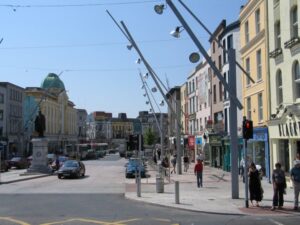
Welcome reader, to the burning of Cork on the 11th of December 1920. Much of the city’s commercial core was burnt out that night by Crown forces in retaliation for an IRA ambush of an Auxiliary patrol at Dillon’s Cross, near the military barracks.
As we stroll along Patrick’s street today. With the bustling crowds, the cool autumn breeze, the people of the city hurrying to-and-fro, it’s difficult to picture the devastation caused during that period, by Crown forces.
Today, as Corkonians stretch their legs on the city streets once more – after one of the world’s strictest COVID lockdowns, there is optimism on the streets once again, as citizens begin to picture a Christmas without lockdown.
The feeling must be akin to the optimism felt by Corkonians at the truce of July 1921; leaving behind the curfews, checkpoints, burnings and killings of the previous eighteen months; a painful and often deadly past.
The Three Struggles
As we walk through the city, along the footsteps of history we can learn a little about the Volunteers’ struggle on our tour of the city.
It’s hard not to reflect on the ideals these men and women gave their lives for. I wonder what they would think of Irish society today? Particularly the gap between rich and poor, house prices, homelessness and the spiralling cost of living?
I’ve been told that the struggle for Irish freedom was really three struggles. One was republican. Another was the feminist struggle for votes and equality for women. The third was the social struggle, for greater equality and a better life for all.
I can’t help but reflect that the first two struggles were achieved to a much greater degree in the city than the third – the social struggle.
The cost of living in the city has never been more expensive. House prices are at an all-time high. Wages are depressed, with many being unemployed after the recent lockdown.
The Rebel County
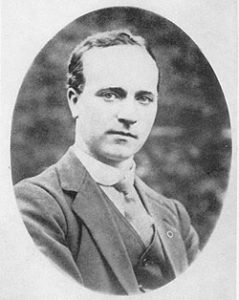
Cork was known as the ‘Rebel city’ from an incident in the 15th century, but it was during the struggle for independence in 1919-1921 that the name was truly earned.
Cork featured prominently in the struggle and is proud of its rebel past. Kent station, the name of the railway station in Cork is named after Thomas Kent, who was executed after the 1916 Rising.
MacCurtain Street, leading from the station to the city centre is named after Tomas MacCurtain, the Lord Mayor of Cork, assassinated by undercover police in March 1920. His successor as Mayor, Terence MacSwiney, was imprisoned and died after an agonising hunger strike in October of that year.
The National Monument statue on Grand Parade is testament to how proud Cork city is of its fighting past. The monument is a celebration of the Irish rebellions of the 19th centuries. And overshadows the monument for Irish soldiers who fought in the First World War in British uniform just a few meters away.
As a result of the prominent role Cork played in the slow and difficult birth of the Irish nation. The city saw its fair share of action.
Scars of the conflict are hidden, just beneath the surface. Concealed to the uninitiated. But if you know where to look, you can find them everywhere.
Reflections on an Assassination
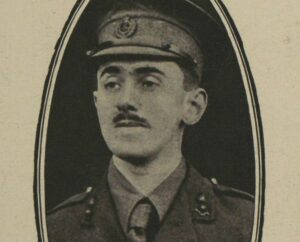
Starting on South Main street; the main business street in the city. 80 Hibernian House still stands. This building housed the Cork Country Club and was the scene of one of the most sensational assassinations by the Volunteers, or IRA, in the city.
Around 15 volunteers burst into the Country Club on the night of the 22nd of July 1920 and their leader declared – before shooting and killing the commissioner – ‘Your orders are to shoot on sight. Well so are ours’.
Commissioner Smyth was the head of the RIC or Crown police force in the county. And had issued orders to shoot-on-sight anyone not immediately cooperating with police forces.
Walking past Hibernian House today, I can’t help but picture the scene. Many of the nearly 12,500 British forces in Cork county were stationed in the city. The Volunteers, simply by operating in the city were taking a huge risk, let alone attempting to assassinate the chief of police.
They timed their assassination to coincide with the end of a movie in the neighbouring cinema, to blend into the crowds and make their escape. The young men were wearing only thinly veiled disguises.
From the other point of view, Police commissioner Smyth’s story was one of tragedy. His brother, a former military an later police officer, had been caught up in the conflict in Dublin and was killed in a shootout at the safehouse of wanted IRA men Dan Breen and Sean Treacy in October 1920.
Located just across the road from the scene of the assassination, lies a war memorial with the names of active volunteers in the Cork brigades of the IRA during the week of the Easter Rising.
Although Smyth was buried with full military honours by British forces at the time, no memorial for Smyth or any of his RIC comrades-in-arms has been erected in the city. Reflecting that history is not just written; but also remembered almost exclusively by the victors.
Just as in modern times; as the war dead from the campaigns in Afghanistan and Iraq demonstrate. Giving your life or health for a losing and futile war, is often a grim prospect and is a fate unbecoming for a brave soldier.
Lives lost in Cork GPO
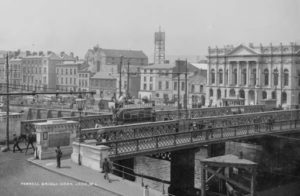
Following a short walk we pass near to the Metropole Hotel, where National Army Commander in Chief Michael Collins spent his last night. Before his date with destiny at the fatal ambush in Beal na Blath at the hands of his former comrades in the anti-Treaty IRA later the next day.
Collins is remembered with his own memorial near University College Cork in the city. Michael was a proud Corkman and is still held in great regard today in the area.
Just around the corner from the old country club, lies Corks General Post Office (GPO), the scene of a Republican raid in which one volunteer and one civilian were fatally wounded.
A group of three volunteers burst into the GPO. Pulled their weapons and proceeded to rob the post office, only to encounter an armed, undercover police officer.
The police officer – most probably a Cork man – must have come to regret his actions on that day. Especially since he found himself on the wrong side of history soon after, in an independent Irish state that celebrated his attackers and at best, ignored his story.
Indeed, the whole conflict was one of internecine warfare. Brother against brother, in the armed struggle to free the Irish nation after 800 years of occupation.
The City comes out for a Funeral
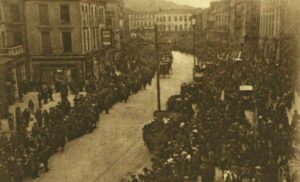
A few hundred meters away from the GPO, across Patrick Street, lies St. Peter and Paul’s church, the scene of the funeral of Michael Fitzgerald. Michael died on a hunger strike in Cork gaol on the 17th of October 1920.
One of many young men to die on both sides of the conflict. Michael was denied his final wish to marry his fiancée before his death by the authorities at the prison.
His funeral was a grand affair. With thousands lining the streets of the city to say farewell to a fallen hero.
You can visit Cork Gaol today and see the cells in which Michael and his comrades served their sentences. Many wrote notes on the walls of their cells. Marking time or leaving messages.
I can’t help but feel that denying Michael the chance to marry his beau before his death from starvation, was just another misguided and ultimately self-inflicted wound committed by the British authorities. And another spectacular defeat in the battle for the hearts-and-minds of the citizens of the city.
Michael is still remembered in the city. And has a road named after him in a suburban neighbourhood.
Finally
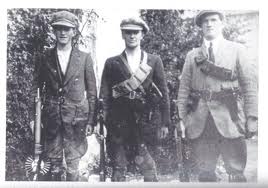
Whether you finish the tour on Barrack street, on South Mall or elsewhere, I hope you will be armed with the knowledge you’ll need to see the city in a whole new light. I hope too that the tour allows you to take a walk in the footsteps of history; and experience the Volunteer struggle 100 years ago.
Most of the buildings caught up in the republican actions during the war of independence still stand, including Elizabeth Fort on Barrack Street, the site of an IRA ambush on a British military convoy, the house on Douglas street where Tadhg O’Sullivan – the Captain of the Cork, Second Brigade of the local IRA was slain and many others.
And although – 100 years later – everything has changed. Much has stayed the same in the city. If you are interested in exploring Cork’s past in a little more detail. The free, online Rebel City Tour of Cork takes you on a tour of the city and tells stories of the volunteer struggle.
Rebel City Tour of Cork
My Rebel City Tour of Cork tries to capture the atmosphere of the city during the Burning of Cork. By guiding you around the city on your smartphone and playing stories of the republican struggle.
We hope you enjoy the tour. Its intention is to be a love letter to Cork’s history. And will be updated and added to over time.
References:
[1] The Rebel City Tour of Cork
[2] CorkHeritage.ie by Kieran McCarthy
[3] War of Independence Exhibit. Crawford Art Gallery. by Dara McGrath.
[4] Controversial RIC Commissioner Shot Dead In Cork City by RTE.ie
[5] Remembering a Cork Patriot Who Died In A Hail of Bullets by Cork Evening Echo Online
Footnote:
This piece was written by Dara Burke. A war of independence and Irish history enthusiast, based in Cork city, Dara works in web development and marketing, and loves helping create passion projects in the online history and tech niche while working as a web developer in cork.